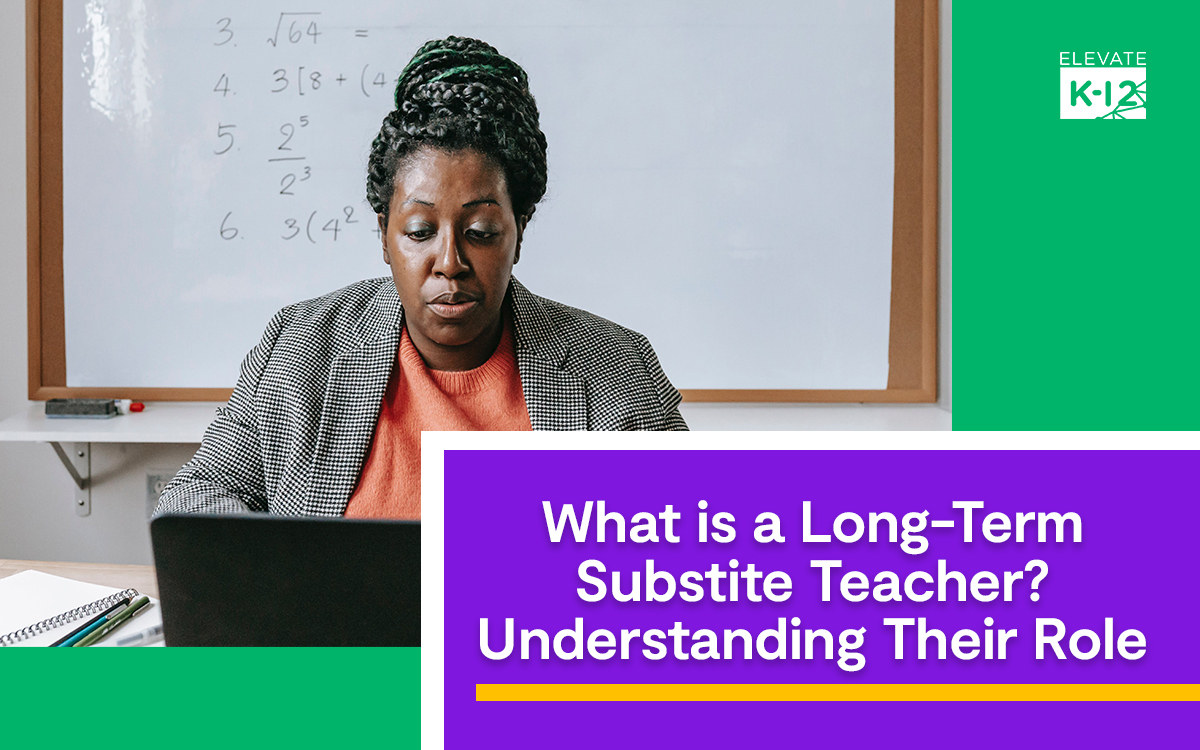From 2021–2022, teacher turnover reached as high as 14%, and the sector hasn’t recovered since. This staffing shortage has made replacing school teachers on leave even more difficult.
Long-term substitute teaching is a solution for many schools. And in a perfect world, it offers students stability who would otherwise have to adapt to multiple teachers with multiple teaching styles. In the real world, though, it’s muddier than that.
Students are already reeling from the disruptions of the pandemic. If schools hope to restore student faith in the educational system, long-term subs may not be the answer. We’ll look at what this role is, its general limitations, and how solutions like Elevate K-12 offer a better path.
What Is a Long-Term Substitute?
A long-term substitute is a teacher who steps in during a full-time teacher’s extended absence. Unlike a short-term substitute teacher, they’re not there to cover a few days but to settle students into a new routine.
Long-term substitutes should have the proper credentials, which can vary by state but often include:
- Emergency Certification Sub Permit
- Teaching Permit for Statutory Leave
- Valid State Teaching Permit
- Certification Matching Assignment
It’s important to note that, in some areas, the requirements for long-term subs are very loose and aren’t as closely regulated as those for licensed teachers. As a result, in times of great need where emergency staffing is needed, those requirements may not be met.
They should also understand who their students are and what they need. The problem is that long-term subs may not even have a basic teaching certification.
Even if they do, they may not have any expertise in the subject area, whether it’s social studies, English, or biology. If they only have a general bachelor’s degree, school districts may struggle with quality control.
When Is a Long-Term Substitute Teacher Necessary?
Originally, long-term substitutes were used as helpful resources to temporarily fill gaps left by full-time teachers’ extended absences — whether due to a family emergency, maternity leave, or serious illness. These substitutes provided coverage until the original school teacher returned or officially resigned.
However, as the teacher shortage worsened, districts have begun to rely on long-term substitutes as the simplest solution. The problem is that long-term subs are often a band-aid for a bigger problem. When the number of teaching jobs outstrips the number of applicants, school leaders may find themselves making big sacrifices for the sake of efficiency.
In the past, the ideal solution would be a short-term substitute while simultaneously sourcing a permanent, licensed, full-time teacher. But recently, long-term subs are being used to fill teaching vacancies from the outset.
The result is a significant decrease in quality control: Because of the nature of a long-term sub, this often means cycling through multiple substitutes until, hopefully, the district can hire a full-time teacher. But in some districts severely affected by the lack of qualified teachers, this still hasn’t happened — even years into the shortage.
The Role of Long-Term Substitutes in Education
As touched on above, the ostensible job description of a long-term sub was once to fill the shoes of a regular teacher during some or all of the school year, but it’s now often used as a much longer-term solution than originally intended. This makes the role a huge responsibility for even the best teachers in the world, partly because it takes time to establish yourself in a student’s life.
The initial shake-up to the classroom routine is just the initial hurdle. While a long-term substitute can impact student engagement positively, the sheer number of variables is enough to set the wrong course.
Challenges of Relying on Long-Term Substitute Teaching
Classroom continuity is more than employing the same day-to-day teacher. From curriculum to engagement, the sink-or-swim environment for a long-term sub puts stress on everyone.
Long-term substitutes that don’t quite ‘fit’ can bring down a student’s educational quality, which can have ramifications for them later in life. We’ll look at the common challenges and consequences.
Lack of Quality Assurance
Long-term substitutes need to know both the subject matter and how to teach it. If they can’t teach the curriculum, which is a strong possibility if they tackle multiple subjects, you’ll see a slowdown in student progress.
Experience and training are crucial to student success. If a long-term teacher has to teach different grade levels, topics, and students every few months, they can’t develop practical solutions to everyday problems. They’re forced to change direction at any given time, which can overwhelm the teacher and students alike.
Whether it’s elementary school or high school, low-quality teaching affects more than a school day. It can lead to a lifetime of resentment against academic institutions of every kind.
Classroom Management
Most people can recall what it’s like to have substitute teachers in their school. Kids may act out, tell lies, or just plain disengage. Long-term teachers struggle with these issues, too — even if they’re brought in for months instead of days.
A long-term teacher has a small window to establish themselves as an authority figure and subject matter expert. If they don’t, it may lead to serious discipline or engagement problems.
Limited Resource Access
Long-term substitutes don’t always have the same resources or support systems as full-time teachers. If they’re always on the outside, they may find it harder to develop lesson plans, assess work, and provide additional student support.
In some cases, limited access is a byproduct of an outdated system, but in others, it’s a deliberate attempt to keep long-term subs separate from full-time classroom teachers. Either way, it hinders student success and may cause subs to switch careers due to a lack of professional development.
When dictating long-term substitute teacher salaries, different districts handle it differently. In fact, in California, some teachers on extended leave are required to pay for their own subs. You can see how uneven resources and policies may lead to a lack of interest in the field.
Potential alternative strategies to manage long-term teacher absences
Regardless of who you choose to fill the role, you’ll face challenges when managing long-term teaching absences. If you’re in a competitive school district, finding a qualified teacher with enough experience in the subject matter and grade level may be easy.
However, if you’re in one of the 86% of school districts struggling with staffing or filling substitute positions, you may need a different approach. To shorten the hurdles, you’ll need to widen the pool of applicants. We’ll look at strategies to accomplish this.
Online Education Platforms
Online education platforms are an interactive suite of online services designed to improve education delivery. These platforms can include courses, programs, articles, quizzes, discussion forums, video lectures, etc.
Elevate K-12 is an innovative educational system providing LIVE teaching to students in lieu of a substitute teacher. With this solution, the teacher is remote while the students are in the classroom.
The difference between this model and the standard long-term sub is that Elevate guarantees reliable, quality teaching. Our teachers are vetted for experience and subject matter expertise and undergo rigorous onboarding and training. They receive ongoing coaching, feedback, and professional development.
With Elevate, district leaders can hand-pick a replacement teacher with a proven track record. Rather than just drawing from a limited (or potentially invisible) pool of applicants, they can rest assured that the teacher can cover the material and handle classroom dynamics.
Schools that use Elevate don’t have to scramble when there’s an unexpected long-term absence. It’s a proactive solution that seamlessly supplies qualified teachers to fill both planned and unplanned vacancies.
LIVE teaching guarantees fewer disruptions in a student learning environment. Subs may come and go, but Elevate ensures that kids receive consistent, quality instruction daily. Plus, Elevate’s teachers have the support staff they need to maintain quality and consistency, regardless of where they teach. Thanks to Onboarding Coordinators and Academic Coaches, our teachers receive feedback and training so they can go the distance.
Co-Teaching Arrangements
Co-teaching arrangements pair a teacher within the district to assume some or all of an absent teacher’s responsibilities. Co-teaching may refer to a teacher from the same school as the absent teacher or a teacher from a nearby school.
This arrangement can be an effective alternative to a long-term substitute. Not only will the teacher understand the district’s expectations, but they may have already successfully taught the same students in the class at a different grade level.
The challenge is managing the extra workload. For districts with teacher shortages, it can be tricky (if not impossible) to find teachers with enough bandwidth. This doesn’t just negatively impact student success; it can cause a quality teacher to feel burnt out.
Staff Reallocation
Staff reallocation is similar to co-teaching in that current staff members are asked to cover the absent teacher’s classes. However, it’s more of a shuffle of either staff, students, or both than a real fix.
With this option, city school districts must either reallocate or adjust responsibilities, which may mean splitting up a class or having multiple teachers cover the same course. This presents significant logistical challenges for schools already struggling with staffing.
For districts already low on resources, staff can be stretched thin with reallocation. Plus, students will instantly feel the strain on the educational quality.
Embrace Innovative Solutions for Long-Term Teacher Absences
Extended teacher absences are common across districts. While co-teaching, long-term subs, or staff reallocation may have been viable solutions in the past, there simply aren’t enough quality teachers for most schools nationwide to fill the gaps.
At Elevate K-12, we believe that experience and subject-matter expertise aren’t a luxury. If a full-time teacher has to leave their post for any reason, students from all backgrounds deserve an equally (if not more) effective teacher to fill their shoes.
If you’ve been having difficulty managing teacher absences, a solution like LIVE teaching can introduce your students to teachers who have the time and the training to succeed. If you want to keep your students engaged in the curriculum you’ve worked so hard to craft and implement, it may be your best option.
If you’re ready for a more effective solution every time a teacher goes on extended leave, check out Elevate K-12 today.

